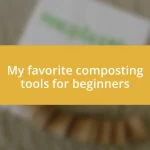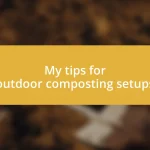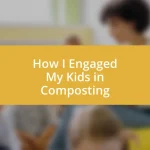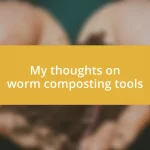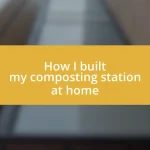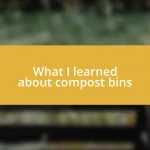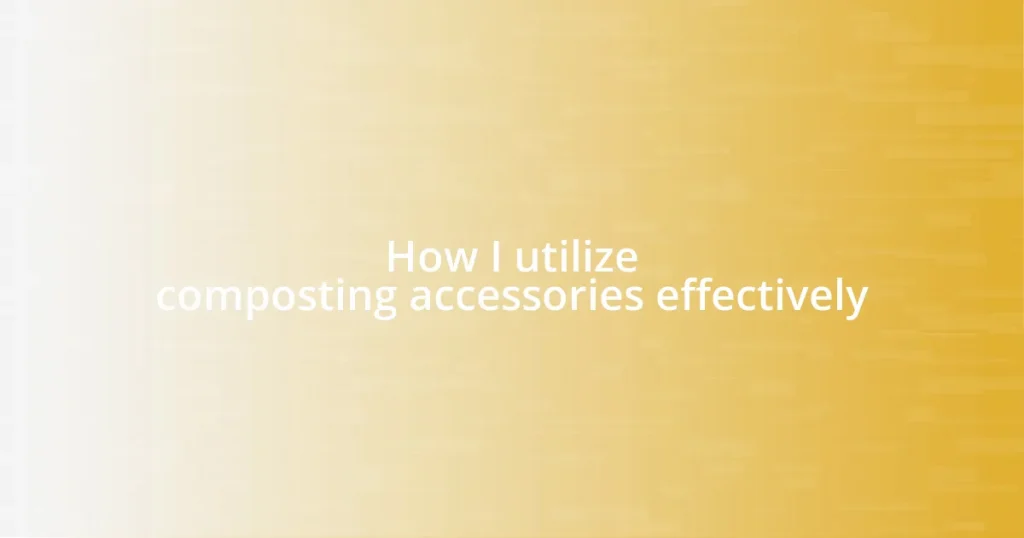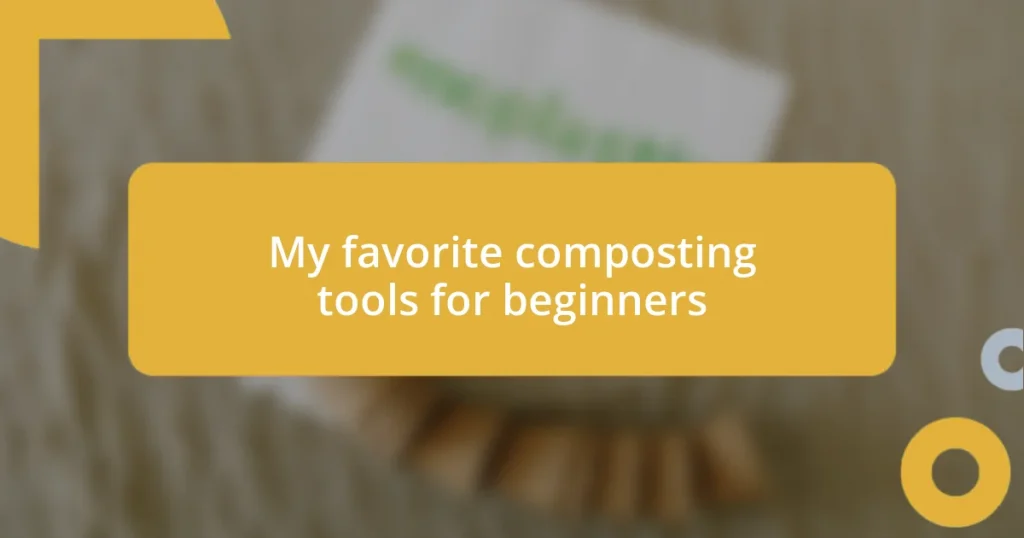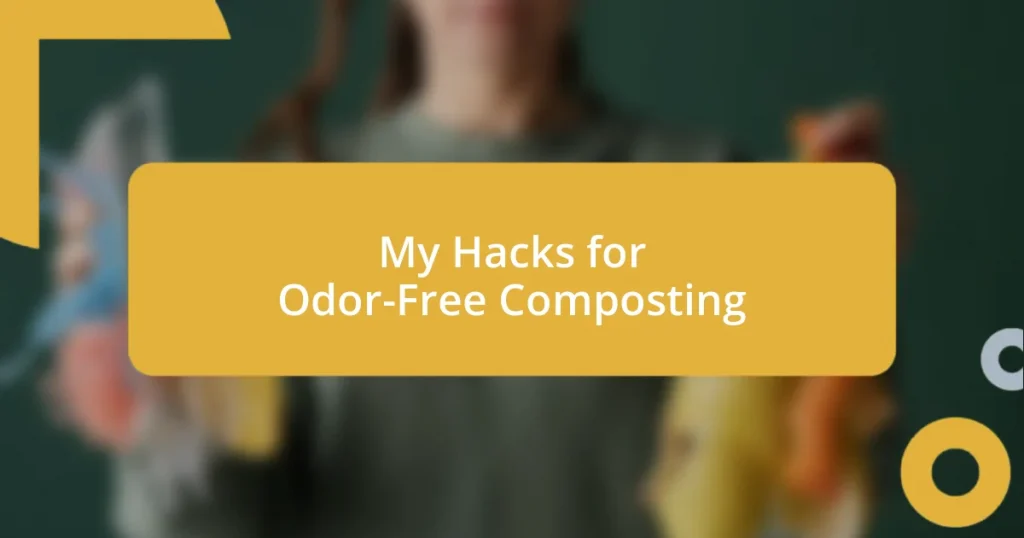Key takeaways:
- Composting requires a balance of carbon-rich “browns” and nitrogen-rich “greens” to prevent odor and ensure effective decomposition.
- Choosing the right composting equipment depends on available space, the type of materials to be composted, and the time you can devote to the process.
- Successful composting involves maintaining the right moisture levels, regularly turning the compost to enhance aeration, and monitoring the carbon-to-nitrogen ratio.

Understanding composting basics
Composting at its core is nature’s way of recycling organic matter. I still remember the first time I added kitchen scraps to my compost bin. I was a bit hesitant, wondering if I’d attract pests, but to my delight, I watched that pile transform, turning waste into black gold over time. It’s a reminder of how life cycles through decay and renewal, don’t you find that fascinating?
Understanding the composting process is essential; it requires a balance of carbon-rich “browns” and nitrogen-rich “greens.” I learned this the hard way during my first attempt when I threw in too many grass clippings without mixing in some dry leaves. The result? A stinky, slimy mess! It taught me that achieving that perfect balance isn’t just about throwing everything together haphazardly; it’s about being mindful of what I’m combining.
Temperature is also crucial for effective composting. I recall checking my compost pile one chilly morning and feeling a rush of excitement when I noticed the steam rising from it. That heat is a signal that the microorganisms are hard at work, breaking down the materials. It’s almost like witnessing a little ecosystem thriving beneath the surface. How rewarding it feels to know that you’re contributing to something larger than yourself!

Types of composting equipment
When diving into the world of composting, the variety of equipment available can be both exciting and overwhelming. From my own experience, choosing the right composting equipment can significantly influence your composting success. I vividly recall my first compost bin; it was a simple wooden structure I built myself. While it served its purpose, I later realized that certain types of equipment could have eased my process and improved the results dramatically.
Here’s a brief overview of some popular types of composting equipment:
- Compost Bins: These come in various materials like plastic, wood, or metal. They help contain the compost pile and keep it tidy while allowing airflow.
- Compost Tumblers: I found tumblers fascinating because they make turning the compost much easier. It’s a hands-on approach that speeds up the composting process.
- Worm Bins: Also known as vermicomposting, these bins use worms to break down organic material. I was amazed to see how effective they were in creating rich compost.
- Open Piles: This is the most natural method, allowing for maximum aeration. However, I learned that proper maintenance is needed to control pests and odor.
- Compost Aerators: These tools help you mix and aerate your compost pile, which can be a game-changer. I wish I had one during my early days, as it would have saved me plenty of time and effort.
Each type has advantages, and selecting the right one can tailor the composting process to fit your lifestyle.

Factors to consider in selection
When selecting composting equipment, I believe one of the most important factors to consider is your available space. I recall moving into a smaller yard and realizing that my beloved large compost bin just wouldn’t fit. This experience made me appreciate how compact options, like worm bins or tumblers, can be perfect for limited spaces. It’s essential to evaluate not just the current space but also any potential changes in your living arrangements.
Another significant consideration is the type of materials you plan to compost. I remember my excitement when I first collected all sorts of kitchen scraps—peelings, eggshells, and even coffee grounds. However, I soon found that my equipment wasn’t suited for larger items like branches or heavy garden waste. It’s crucial to choose equipment that accommodates everything you intend to compost without causing frustration.
Lastly, think about the time and effort you’re willing to invest in the composting process. I’ve experienced both quick and labor-intensive methods, and what I found is that the ease-of-use aspect really matters. For example, the convenience of a compost tumbler saved me countless hours compared to hand-turning my pile with a pitchfork. Understanding your time commitment will ensure you select equipment that aligns with your lifestyle and leads to successful composting.
| Factor | Description |
|---|---|
| Available Space | Consider the size and layout of your space for a suitable composting system. |
| Materials to Compost | Ensure your equipment can handle the variety of organic materials you plan to compost. |
| Time & Effort | Choose equipment based on how much time you’re willing to dedicate to the composting process. |

Comparing different composting systems
In my journey of composting, I found that compost bins are often seen as the starter kit for any new composter. In fact, my first experience doing so was with a basic bin, and while I appreciated its simplicity, I later encountered the spaciousness of larger tumblers. Isn’t it interesting how our perceptions evolve? The convenience factor becomes apparent when you realize that with a tumbler, you’re not just composting—you’re creating a living ecosystem in your backyard.
On the other hand, open piles can be a liberating experience for those willing to embrace a somewhat chaotic approach. I remember the initial thrill of throwing everything in a heap, letting nature take its course. Still, a nagging thought crept in: could I maintain enough control over my compost? The freedom of mixing materials naturally gave me a sense of connection to the earth, but there’s undeniable responsibility in ensuring that things don’t go awry with odors or pests.
Then there’s the marvel of worm bins, which I initially underestimated. The moment I grabbed my first handful of rich, vermicomposted soil, I was hooked! The transformation driven by those little workhorses is simply magical. How can such tiny creatures create such nutrient-dense compost? It’s a testament to the wonders of nature, and I can assure you, the return on investment in a worm bin can be astounding for any home gardener.

Evaluating composting equipment efficiency
When evaluating the efficiency of composting equipment, I often reflect on how well it balances speed and simplicity. For instance, after switching to a rotating composter, I genuinely marveled at how quickly my kitchen scraps turned into rich, dark compost. The rotation not only speeds up the aeration process but also keeps the materials evenly mixed—a crucial step in the composting journey. Have you ever wondered how much faster you could compost with the right setup? Trust me, it makes a noticeable difference.
Another angle to consider is the thermal performance of your composting system. I recall overheating my traditional bin a few times because I packed it too tightly without allowing for airflow. It took a bit of trial and error, but eventually, I learned that efficient composting relies on maintaining the right balance of carbon and nitrogen as well as proper aeration. Isn’t it fascinating how the science behind composting directly links to the health of our plants?
Lastly, durability and maintenance cannot be overlooked when assessing equipment efficiency. I invested in a sturdy plastic tumbler that withstands both the elements and frequent use. In my opinion, equipment that requires minimal maintenance allows me to focus more on the joy of composting rather than repairs. I’ve come to appreciate that efficiency isn’t just about speed; it’s also about how easily it fits into my life. How has your experience been with maintaining your composting equipment? It certainly shapes the overall efficacy of the composting process.

Budgeting for composting equipment
Budgeting for composting equipment can seem daunting, but I’ve learned that it’s all about finding the right balance between quality and affordability. When I first started, I spent more on fancy gadgets that promised magical results. However, after some experience, I realized that simple, robust equipment often worked just as well—or even better. Have you ever bought something expecting it to be a miracle tool, only to find it didn’t live up to the hype?
As I evaluated my budget, I began to appreciate the value of secondhand options when it comes to composting gear. I once stumbled upon a well-loved compost bin at a local garage sale for a fraction of the retail price. Not only did it save me money, but it also added a unique charm to my garden. I truly believe that good composting doesn’t have to come with a hefty price tag. How much have you spent on that perfect composting tool, only to realize it was all marketing?
Finally, I suggest considering the long-term savings associated with composting equipment. Investing a bit more upfront in a durable tumbler, for instance, can yield rich compost for years, reducing the need for chemical fertilizers. It’s like planting the seed of savings that grows year after year. Have you calculated how much you could save on garden supplies with a successful composting system? I frequently find myself reflecting on that investment—realizing that my compost not only nurtures my plants but also nurtures my wallet.

Tips for successful composting use
When it comes to successful composting, one key tip I’ve found invaluable is to maintain a balanced mix of greens and browns. Initially, I tossed in all my kitchen scraps without considering the carbon-to-nitrogen ratio. After a few smelly, slimy batches, I learned the importance of adding dry leaves and paper to keep things balanced. Have you ever had a compost pile go sour? It can be a bit disheartening, but once I got the mix right, the transformation was astonishing!
Regularly turning your compost is another technique that dramatically benefits the process. I recall a time where I neglected to give my bin a good turn for a couple of weeks, and the difference was palpable. The compost smelled stale, and the breakdown slowed significantly. Making it a habit to turn the pile every couple of weeks not only enhances aeration but also speeds up decomposition. Isn’t it rewarding to see how a little effort can lead to big results?
Lastly, it’s crucial to monitor moisture levels in your compost. I once had a batch that dried out too much, and it became a challenge to revive it. Since then, I’ve learned that composting should resemble a damp sponge—not too wet and not too dry. Engaging with the compost daily gives you an opportunity to observe these factors and adjust accordingly. Have you felt the texture of your compost? That tactile feedback can tell you so much about the health of your mix!

